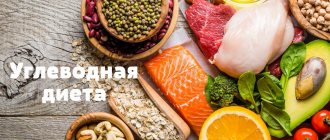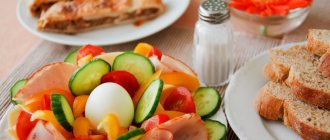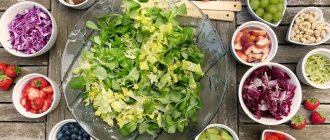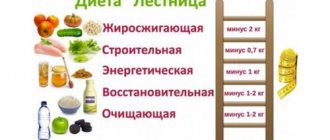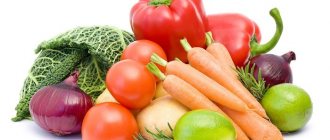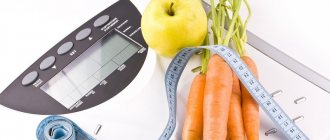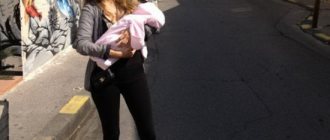Quick navigation through the article:
- Detailed description
- Diet structure
- Features of BUCH
- General recommendations
- Sample menu for the week
- Menu for the month
- Four-day rotation
- BUCH according to the Malysheva system
- Diet recipes
- Advantages and disadvantages
- Contraindications
- Heidi Powell experiment
- Reviews and results with photos
BUTCH diet plan
The BUTCH diet can last from 4 to 30 days. A person must independently decide which option suits him best. This largely depends on your initial body weight and what result you want to achieve. An important condition is that the number of days during the diet must be a multiple of four.
The most effective BEACH diet plan:
- First day: the daily dose of protein is calculated based on the scheme of 3-4 g of protein per 1 kg of weight. The amount of carbohydrates from food is equal to 25 g, and the amount of fat to 30 g.
- The second day is similar to the first day.
- The third day involves eating 1 g of protein and 6 g of carbohydrates per 1 kg of weight. Fats should be present in the menu, but not more than 30 g per day.
- During the 4th day of the diet, you need to consume 3 g of protein and 3 g of carbohydrates per kilogram of weight. The amount of fat remains unchanged.
In addition to the classic scheme of alternating days on a BEACH diet presented above, there are its variations:
- 2+2 (protein days + carbohydrate days).
- 2+1 (protein days + carbohydrate days).
- 3+1+1 (protein + carbohydrate + protein-carbohydrate).
- 2+2+2 (protein + carbohydrates + protein-carbohydrates).
The daily caloric intake for women on any of these days should be equal to 1200 kcal.
A regimen that includes a large number of protein days is more suitable for gaining muscle mass. At the same time, fat will also be burned. Be sure to exercise while dieting.
Experts consider the optimal regimen to be one in which 2 protein days alternate with 2 carbohydrate days. If you increase the number of protein days, it will be more difficult for the body to tolerate the diet.
As for quitting the diet, it is not particularly difficult. To do this, it is enough to continue to eat a mixed diet for another week, introducing foods from the usual menu into the diet every day.
Effect on the body
A balanced and delicate protein-carbohydrate diet for weight loss with a rich menu gives a signal to the body to burn its own fat reserves without the feeling of hunger and exhaustion. What happens in the process:
- burning fat without using muscle fibers. The body becomes embossed;
- losing weight on protein days;
- carbohydrate days replenish energy reserves, provide strength and prevent depression, and maintain performance;
- the body receives important macroelements, so hair, nails, skin and health do not suffer;
- A variety of food enters the stomach, so there is no getting used to a certain set of foods.
The most important thing is the absence of stress for the central nervous system and a full menu with useful microelements, so a protein-carbohydrate diet maintains the health of those losing weight without affecting the quality of life.
Results of the BUCH diet
The results of the BUC diet are presented in the following graph:
- Minus 0.5 kg - 1 kg in the first 1-2 days of the diet.
- Minus 0.5 kg - 1 kg on day 3-4 of the diet.
- On the fifth day of the diet, it is possible to regain the lost kilos due to the water that will be retained in the body by carbohydrate foods.
- On the sixth day of the diet, losses are similar to those that occur during the second day.
If you repeat the cycle, you will lose approximately 0.8 kg for each approach. However, during a BEACH diet, attention should be paid not to exactly how much a person has lost in kilograms, but to how much the volume has decreased.
Omelette with green beans
Suitable for a protein day. Need to:
- 2 eggs;
- half a glass of milk;
- green beans (no matter, for one serving).
Preparation:
- The proteins are separated.
- Beat them with milk.
- Pour this mixture over lightly fried green beans in butter.
- Cook in the oven for 10 minutes.
You need to exit the BUTCH diet wisely. In no case should you increase the volume of portions and calorie intake immediately after it ends. During this entire time, you need to maintain the correct drinking regime - at least 2 liters of clean water per day.
BUTCH diet menu
BUTCH diet menu for the week:
| Breakfast | Snack | Dinner | Dinner | |
| Protein day No. 1 | Whipped cottage cheese, black coffee | Choice of: nuts, yogurt or kefir | Mushroom soup, stewed chicken and beans | Chicken liver in milk |
| Protein day No. 2 | Chicken frittata with mushrooms, glass of coffee | Rabbit meat with pea puree | Seafood in tomato sauce | |
| Day No. 3 - carbohydrate | Yachka cooked with milk | Any fruit | Vegetables and boiled rice | Warm vegetable salad, lentils |
| Day No. 4 - combined | Whole grain cereal with milk, glass of coffee | Any fruits, nuts or kefir | Vegetable soup, vegetables with beef fillet | Cheese casserole |
| Day No. 5 - protein | Cottage cheese, yogurt, coffee | Yogurt, nuts or kefir at the discretion of the person losing weight | Spinach puree soup, chicken fillet in soy sauce and kefir | Vegetable salad with Tofu cheese |
| Day No. 6 – protein | Omelette (2 whites + 1 yolk), glass of coffee | Red fish fillet, steamed red beans in tomato sauce | Beef stewed in cream, vegetable salad | |
| Day No. 7 - carbohydrate | Oatmeal porridge cooked with milk, cup of coffee | Any fruit | Vegetable soup with barley, boiled buckwheat with mushrooms | Pancakes with vegetable filling |
| Day No. 8 – leaving the diet | Omelet based on two chicken eggs, a cup of coffee | Nuts, kefir or fruits | Steamed white fish, pasta and spinach | Goat cheese and vegetables in salad |
BUTCH for weight maintenance
Protein-carbohydrate alternation is well suited for those who need to gradually exit the diet and tune in to maintenance, or for those who quickly adapt to higher calories and begin to gain fat mass.
Training and training on supporting numbers will help maintain muscle relief after drying, and excellent appearance.
Support calculations are carried out as follows:
- Half of the maintenance calories are proteins;
- The rest is half and half between fats and carbohydrates;
- Carbohydrates on a high day 50%, on a low day – 25%
How is this different from regular nutrition? Fats will be proportionally reduced on a high carb day.
Allowed products of the BEACH diet
During protein days, the following foods may be present on the table:
- Meat products: chicken fillet, veal, rabbit meat, lamb, low-fat pork and beef, pheasant and turkey.
- Seafood: squid and octopus, lobster, mussels, shrimp. Allowed fish: hake, halibut, cod, pink salmon, flounder, salmon, tuna, trout and salmon.
- Milk-based products: yogurt, fermented baked milk, low-fat cottage cheese and feta cheese, kefir, yogurt, milk.
- Chicken eggs. The amount of proteins is limited by the appetite of the person losing weight, but no more than one yolk per day.
- Nuts.
- Legumes.
Products that may be on the table during carbohydrate days:
- Cereals: millet, oatmeal, rice, buckwheat, egg, millet groats, etc.
- Pasta and bread made from rye flour, with the addition of bran flour or based on durum wheat flour.
- Fruits that don't contain a lot of sugar.
- Vegetables that do not contain a lot of starch.
- Greenery.
- Bran.
Menu on BUCH
Protein-carbohydrate alternation is a diet with strict rules, and therefore there are prohibited and permitted foods. Moreover, for each day of the plan they will be different. Let's find out what you can and can't eat on BEACH, how to properly create a diet and what to do after finishing the diet.
What products are allowed and prohibited?
For protein days, you will have to purchase all kinds of protein-rich foods. These include:
- Meat and poultry, it is better to choose lean beef, chicken and turkey.
- White and red fish, as well as seafood.
- Low-fat dairy products with a minimum of carbohydrates, for example, cottage cheese, kefir, milk, yogurt.
- Eggs and offal, such as chicken or beef liver.
- Also, a small amount of non-starchy vegetables and herbs is allowed in the diet.
For carbohydrate and mixed days you will need:
- Cereals and grains: rice, oatmeal, quinoa, bulgur, buckwheat, pearl barley, wholemeal bread and pasta.
- Vegetables, preferably fresh or green vegetables.
- It is better to choose fruits that are not too sweet and low in calories, for example, green apples and citrus fruits.
- Legumes and nuts.
- Any proteins from the above.
On carbohydrate and mixed days, it is recommended to adhere to proper nutrition so as not to gain weight the next day.
What is prohibited:
- In terms of prohibited foods in the BUCH scheme, everything is standard: you can’t eat sweets, alcohol, fast food, white flour, fried foods, fatty meats, fatty dairy products and other junk foods.
- On protein days, almost all carbohydrates are prohibited, except the very minimum. But on carbohydrate days, you can and should eat proteins, as in any balanced diet.
- On carbohydrate and mixed days, you can allow yourself indulgences, but only if they fit into the carbohydrate norm.
Sample menu for a protein day
Let's move on to creating a menu for protein-carbohydrate alternation. Protein days are considered the most important, so you should approach diet planning seriously and not reduce your protein intake. Below are 3 options for a protein menu, but you can create your own diet by analogy.
Option 1
- Breakfast: 2-3 egg omelet with milk and herbs + a cup of espresso.
- Snack: natural yogurt with a teaspoon of fiber.
- Lunch: baked chicken + salad of fresh vegetables and herbs.
- Snack: low-fat cottage cheese with a spoonful of sugar-free peanut butter, you can add another spoonful of fiber.
- Dinner: baked chicken with a small amount of vegetables and herbs.
Option 2
- Breakfast: cottage cheese with flax seeds, sesame seeds and a teaspoon of honey or peanut butter + coffee.
- Snack: Greek yogurt with a teaspoon of fiber.
- Lunch: beef stew with vegetables (cauliflower, broccoli, green peas).
- Snack: a glass of kefir.
- Dinner: baked mackerel with mushrooms and onions + tomato and cucumber salad.
Option 3
- Breakfast: two scrambled eggs with tomatoes and herbs + coffee.
- Snack: drinking yogurt.
- Lunch: turkey or chicken with stewed vegetables + arugula salad or other greens.
- Snack: cottage cheese with sesame seeds.
- Dinner: grilled fish with lemon and herbs.
We recommend watching:
- Ready-made menu for 1500 calories: plan for 7 days with KBZHU
- Ready-made menu for 1200 calories: plan for 7 days with KBZHU
Sample menu for a carbohydrate day
There are also rules for a carbohydrate day. For example, it is not recommended to exceed the carbohydrate limit, otherwise the body will begin to retain water, which will result in weight gain. Follow our menu to ensure your carb day goes off without a hitch.
Option 1:
- Breakfast: oatmeal with water + coffee with milk + orange or grapefruit (or juice from them).
- Snack: a small handful of nuts.
- Lunch: meat stew with beans, tomatoes and other vegetables.
- Snack: banana.
- Dinner: buckwheat porridge + seafood and herbs salad.
Option 2:
- Breakfast: toast with peanut butter, honey and cream cheese + coffee.
- Snack: 30 g hard cheese.
- Lunch: chicken soup with onions, green peas and potatoes.
- Snack: apple or grapefruit.
- Dinner: rice or bulgur with vegetables and liver.
Option 3:
- Breakfast: sugar-free muesli with milk + coffee or tea without sugar.
- Snack: smoothie made from natural yogurt and banana.
- Lunch: chickpea, bean or broad bean stew with chicken and seasonal vegetables.
- Snack: large apple, pear or orange.
- Dinner: buckwheat porridge with tomato and mozzarella salad (or other soft cheese).
Sample menu for a mixed day
On a mixed day, it is recommended to eat equal amounts of protein and carbohydrates. This means that each meal should include protein and a small amount of carbohydrates. Let's see what this looks like in practice:
Option 1:
- Breakfast: A sandwich of black or bran bread with soft cottage cheese and a slice of hard cheese + coffee.
- Snack: yogurt with honey.
- Lunch: baked chicken breast + buckwheat + herb and tomato salad.
- Snack: a handful of nuts and a small pear.
- Dinner: grilled fish + brown rice with vegetables.
Option 2:
- Breakfast: salad of eggs, low-fat cheese, tomatoes and herbs, dressed with lemon and yogurt.
- Snack: a handful of mixed nuts and dried fruits.
- Lunch: meat stew with vegetables + buckwheat porridge.
- Snack: banana.
- Dinner: oven-baked fish + rice + vegetable salad with lemon juice.
Option 3:
- Breakfast: cheesecakes + coffee.
- Snack: pear and grapefruit salad with yogurt.
- Lunch: baked chicken + durum wheat pasta + tomato and cucumber salad.
- Snack: orange.
- Dinner: rice with seafood.
Entry and exit from the diet
A sudden change in diet can be a serious stress for the body. Therefore, before starting the diet, it is recommended to prepare.
A week before the start of the BJU, determine your BZHU norm for each day of the plan and develop a menu. A couple of days before starting the diet, eat according to the rules of a mixed day with a moderate reduction in carbohydrates. At the same time, the calorie content of the diet should not be too low. This way you will help your body gently prepare for protein days and be able to withstand them without severe stress.
You should also leave the diet on mixed days. Moreover, you can stick to the mixed days menu for a few more days after. Of course, you shouldn’t immediately load up on fast carbohydrates after finishing your diet. Otherwise, in a couple of days you can regain all the lost kilograms. In general, after BCH you should adhere to a balanced diet in order to maintain the results for a long time.
Prohibited foods of the BEACH diet
Foods that should not be eaten during the BEACH diet:
- Any fatty meat.
- Any sausages, lard, ham, bacon, etc.
- Fast food.
- All products that contain sugar (jam, sweets, chocolate, etc.).
- Dried fruits.
- Ice cream.
- Potato.
- Whole milk.
- Bread made from wheat flour.
- Fermented milk drinks and foods that contain a high percentage of fat.
- All sweet fruits: watermelons, pineapples, persimmons, grapes.
- Juice from sweet fruits.
- Products containing caffeine.
- Alcohol.
- Drinks containing gases.
- Rusks and cakes, gingerbread and waffles.
- Porridges are not made from whole grains.
| Product category | Squirrels | Fats | Carbohydrates | Kilocalories |
| Vegetables, fruits, dried fruits, berries, herbs, nuts, mushrooms | ||||
| Fried potatoes | 2,8 | 9,5 | 23,4 | 192 |
| Radish | 1,2 | 0,1 | 3,4 | 19 |
| Turnip | 1,5 | 0,1 | 6,2 | 30 |
| Beet | 1,5 | 0,1 | 8,8 | 40 |
| Figs | 0,7 | 0,2 | 13,7 | 49 |
| Grape | 0,6 | 0,2 | 16,8 | 65 |
| Mushrooms | 3,5 | 2 | 2,5 | 30 |
| Raisin | 2,9 | 0,6 | 66 | 264 |
| Dates | 2,5 | 0,5 | 69,2 | 274 |
| Cereals, flour products, bread | ||||
| Corn grits | 8,3 | 1,2 | 75 | 337 |
| Pancakes | 6,1 | 12,3 | 26 | 233 |
| Vareniki | 7,6 | 2,3 | 18,7 | 155 |
| Dumplings | 11,9 | 12,4 | 29 | 275 |
| Buns | 7,2 | 6,2 | 51 | 317 |
| Wheat bread | 8,1 | 1 | 48,8 | 242 |
| Sweets | ||||
| Jam | 0,3 | 0,2 | 63 | 263 |
| Jam | 0,3 | 0,1 | 56 | 238 |
| Candies | 4,3 | 19,8 | 67,5 | 453 |
| Cake | 3,8 | 22,6 | 47 | 397 |
| Jam | 0,4 | 0,2 | 58,6 | 233 |
| Halva | 11,6 | 29,7 | 54 | 523 |
| Cake | 4,4 | 23,4 | 45,2 | 407 |
| Chocolate | 5,4 | 35,3 | 56,5 | 544 |
| Sauces, raw materials, seasonings | ||||
| Ketchup | 1,8 | 1 | 22,2 | 93 |
| Mayonnaise | 2,4 | 67 | 3,9 | 627 |
| Honey | 0,8 | 0 | 81,5 | 329 |
| Sugar | 0 | 0 | 99,7 | 398 |
| Dairy | ||||
| Condensed milk | 7,2 | 8,5 | 56 | 320 |
| Cream | 2,8 | 20 | 3,7 | 205 |
| Yogurt with fruit 3.2% fat | 5 | 3,2 | 8,5 | 85 |
| Meat, sausage, fish | ||||
| Roast pork | 11,4 | 49,3 | 0 | 489 |
| Salo | 2,4 | 89 | 0 | 797 |
| Bacon | 23 | 45 | 0 | 500 |
| Boiled-smoked sausage | 28,2 | 27,5 | 0 | 360 |
| Dried sausage | 24,1 | 38,3 | 1 | 455 |
| Duck | 16,5 | 61,2 | 0 | 346 |
| Goose | 16,1 | 33,3 | 0 | 364 |
| Fried fish | 19,5 | 11,7 | 6,2 | 206 |
| Smoked fish | 26,8 | 9,9 | 0 | 196 |
| Canned fish | 17,5 | 2 | 0 | 88 |
| Beverages | ||||
| Dessert white wine, 16% | 0,5 | 0 | 16 | 153 |
| Vodka | 0 | 0 | 0,1 | 235 |
| Cognac | 0 | 0 | 0,1 | 239 |
| Liquor | 0,3 | 1,1 | 17,2 | 242 |
| Beer | 0,3 | 0 | 4,6 | 42 |
| Bread kvass | 0,2 | 0 | 5,2 | 27 |
| Coca Cola | 0 | 0 | 10,4 | 58 |
| Coffee with sugar and milk | 0,7 | 1 | 11,2 | 38 |
| Pepsi | 0 | 0 | 8,7 | 45 |
| Energetik | 0 | 0 | 11,3 | 81 |
| Compote | 0,5 | 0 | 19,5 | 54 |
| Grape juice | 0,3 | 0 | 14 | |
Age-related diet features
The BUCH system is designed for young people who lead an active lifestyle. As you age, your body requires less protein. The diet described is ideal for a young girl. Older women have to make their own adjustments to this system.
After 40 years, calcium is especially important. Therefore, it is advisable to choose cottage cheese for breakfast. Toast with low-fat cheese is suitable as a snack. These products are leaders in both protein and calcium content. To lose weight, you need to eat more vegetables, combining them in different ways and using different cooking techniques.
Women can use the following recipes for a carbohydrate day.
Butternut squash pancakes
Necessary:
- 200 g raw pumpkin pulp;
- 1 egg;
- 2-2.5 tbsp. l. oat flakes (fine or pre-chopped);
- 3 tbsp. l. crushed and dried walnuts;
- spices - to taste.
Preparation:
- The pumpkin pulp is mixed with an egg, flakes, and a small amount of salt.
- Pumpkin pancakes are fried in a non-stick frying pan, then you can do without oil.
- At the end, add nuts.
Pumpkin contains vitamin A and selenium.
Celery soup
For 1.5 liters of vegetable broth you will need:
- 1 large celery root;
- 1 onion;
- half a glass of walnuts;
- 2-3 tbsp. l. wheat flour;
- 30-40 g flour;
- cheese, salt and spices to taste.
Preparation:
- Celery is grated.
- Onions and walnuts are chopped.
- The ingredients are lightly fried in a small amount of vegetable oil.
- Cool slightly.
- Gradually add vegetable broth, stirring lightly.
- Bring the soup to a boil, reduce the heat and leave for another 20 minutes.
- Blend in a blender until smooth.
- Add grated cheese to the soup that has not yet cooled down.
Vegetable casserole
You will need:
- 2 eggplants;
- 2-3 zucchini (you should not replace them with zucchini, since the latter are more watery);
- 3 tomatoes;
- 2 pcs. bell pepper;
- 200 g broccoli;
- a couple of cloves of garlic;
- 1 tbsp. l. vegetable oil;
- spices (basil, paprika, pepper), salt to taste.
Preparation:
- The tomatoes are first scalded to remove the skin.
- Zucchini and eggplant are cut into slices, and peppers are cut into cubes or strips.
- Each broccoli floret is cut in half.
- The mold is greased with oil.
- Vegetables are laid in layers.
- The dish is peppered, salted, chopped garlic and basil are added.
- Place in the oven and cook for 30-40 minutes.
Recipes for protein days BEACH diet
Curd omelette
To prepare the dish you will need the following products:
- Chicken egg white – 2 pcs.
- Cottage cheese with 0% fat content – 100 g.
- Water.
- Seasonings.
- Greenery.
Beat the eggs with a fork, mix with cottage cheese and add chopped herbs to the dish. Salt to taste. Grease a heat-resistant form with olive oil and place the curd-egg mixture into it. Bake the casserole in the oven with the lid closed at 180 °C. Cooking time is a quarter of an hour.
Chicken salad with egg and squid
To prepare the dish you will need the following products:
- 0.5 kg squid.
- Chicken egg – 3 pieces.
- 0.3 kg chicken fillet.
- Seasonings, salt and herbs are at the discretion of the cook.
Squid and chicken fillet are boiled and cut into long strips. Boiled eggs are cut into cubes, greens are chopped. All salad components are mixed, salted, and herbs are added.
Baked fish with cheese
To prepare the dish you will need the following products:
- 0.5 kg tilapia or pike perch.
- 50 g cheese.
- 2 tablespoons of sour cream.
- 1/4 part lemon.
- Salt and pepper to taste.
The cheese is grated, the fish is salted and peppered, and placed in a baking dish. Sprinkle the fish with a teaspoon of lemon zest on top, pour over lemon juice, and brush with sour cream. The last step is to cover the fish with grated cheese. Place the mold in a preheated oven and cook for a quarter of an hour at 180 °C.
Baked chicken with herbs
To prepare the dish you will need the following products:
- 0.25 kg chicken fillet.
- 50 g kefir.
- Green onions and dill.
- Salt and pepper.
Chicken fillet is beaten, sprinkled with pepper and salt, greased with kefir, and chopped herbs are placed on a layer. Roll the breast into a roll shape and place it in a baking sleeve. Cook the chicken at 180 °C for half an hour.
Cottage cheese and pumpkin casserole in the oven
To prepare the dish you will need the following products:
- 0.3 kg of cottage cheese.
- 0.4 kg pumpkin.
- 30 g butter.
- Two tablespoons of sour cream.
- Lemon juice.
- A pinch of salt.
- 1/4 teaspoon baking soda.
- Two eggs.
- Two tablespoons of semolina.
The pumpkin pulp is grated, the cottage cheese is kneaded with a fork along with butter. Add raw eggs, semolina, sugar, soda slaked with vinegar, and grated pumpkin into the cottage cheese. All components are thoroughly mixed. Grease a baking dish with butter, place the prepared curd-pumpkin mixture into it and put it in the oven. Cook the dish for 50 minutes at a temperature of 200 °C.
Products
There is no universal table of all products. Different dishes are prepared depending on the goal and initial parameters. It is allowed to gradually introduce or remove ingredients from the BUTCH menu for each day. For each person, the amount of food taken is individual. The main feature of the diet is moderate nutrition. The daily standard calorie requirement for women with low activity is 1200, for athletes - 1600.
Allowed
Fat is practically prohibited; you can consume 1 tsp per day. oils You will need it for dressing salads. When losing weight, the fat content of foods decreases. Athletes can consume dairy products and medium-fat cheese to improve their body shape.
Protein days
On such days, the basic products are as follows:
- boiled lean beef;
- turkey and chicken breast;
- cottage cheese with 0% fat content;
- cooked seafood, caviar, fish;
- hard-boiled eggs.
Meat and fish should be used boiled or baked; fried food should be forgotten for a while.
Carbohydrate days
“Slow carbohydrates” suitable for these days are:
- cereals: semolina, pearl barley, oatmeal;
- pasta;
- steamed rice;
- pineapple, pomegranate, carrots, boiled beans, beets.
In a mixed diet, products are consumed in a 1:1 ratio. When preparing dishes, salt is used minimally, but not completely excluded. Greens can be added to all dishes in unlimited quantities; dry natural seasonings are used.
Prohibited
This method does not allow the consumption of sugar and sweet fruits. Dried fruits can replace these products.
For a person losing weight using such a system, there is no room in the house for the following products:
- ketchup;
- soy sauce;
- mayonnaise;
- syrups;
- sugar substitutes;
- sweet drinks.
If the required ingredient is not among the permitted products, then it is in the prohibited area. When purchasing food products, you need to read the ingredients on the packaging. The presence of flavor enhancers in the composition immediately places this product in the category of prohibited.
Recipes for carbohydrate days of the BEACH diet
Pancakes with mushrooms
To prepare the dish you will need the following products:
- Whole grain flour – 1 cup.
- Fried champignons – 1 cup.
- Low-fat kefir - 0.75 cups.
- Mineral water – 1/2 cup.
- Olive oil – a teaspoon.
- Half a teaspoon each of chopped parsley and onion.
- A clove of garlic.
- A little baking powder.
- Salt.
The greens are finely chopped, the garlic is passed through a press. Grease a frying pan with oil and fry herbs and mushrooms in it. Cook them with the lid closed for 20 minutes.
Preparation of the dough: sift the flour, add salt to it. Separately, beat eggs with kefir, water and oil, mix with flour. Pancakes are made from the prepared dough.
Mushroom filling is wrapped in pancakes and served hot.
Pasta casserole
To prepare the dish you will need the following products:
- Pasta.
- Greenery.
- Two chicken eggs.
- Low fat cheese.
- Pepper and salt.
Boil pasta until half cooked, add chopped herbs, salt and pepper. Season the pasta with beaten raw eggs and bake in the oven for half an hour. At the end of cooking, sprinkle the pasta with low-fat cheese.
Buckwheat cutlets with mushrooms
To prepare the dish you will need the following products:
- 1/2 cup buckwheat.
- Carrots – 1 piece.
- 0.1 kg champignons.
- A teaspoon of vegetable oil.
- A tablespoon of flour.
- 30 g vegetable oil for frying.
- Salt and pepper to taste.
Buckwheat is boiled until fully cooked and passed through a blender. Mushrooms and onions are cut, carrots are grated. Fry onions with mushrooms, cool and mix with grated carrots and ground buckwheat, salt and pepper, add flour and vegetable oil. Form cutlets from minced meat, roll them in breadcrumbs, and fry in vegetable oil on both sides for no more than 3-5 minutes. You can serve these cutlets with adjika.
Creamy soup with pumpkin and lentils
To prepare the dish you will need the following products:
- 0.24 kg of onions.
- 0.28 kg carrots.
- 0.8 kg pumpkin.
- 2 liters of water.
- 0.2 kg lentils.
- 0.43 kg potatoes.
- Half a teaspoon of ground nutmeg.
- Ground black pepper.
- 140 ml cream 10% fat
- 140 g black bread.
- 2 tablespoons olive oil.
- Salt to taste.
Onions and carrots are cut into quarters and simmered in a saucepan for no more than 5 minutes with butter. Add the diced pumpkin to the onions and carrots and simmer for another 3 minutes. Pour water into the vegetables and bring to a boil. When the soup boils, add lentils to it, cook over low heat, do not cover with a lid. After 15 minutes of cooking, add diced potatoes, pepper, and nutmeg to the soup. Cook for another 10 minutes. At this time, brown bread, cut into cubes, is baked in an oven preheated to 180 °C. Cooking time for crackers is 5 minutes.
The soup is salted, passed through a blender, cream is added and boiled for another 3 minutes. The dish is served with herbs, croutons and pumpkin seeds.
Pizza with eggplant
To prepare the dish you will need the following products:
- 0.25 kg flour.
- 15 g yeast.
- A pinch of salt.
- A tablespoon of olive oil.
- Eggplant sauce - 5 tablespoons.
- Oregano
- Warm water.
Ingredients for making eggplant sauce: 1 onion, two cloves of garlic, 4 tomatoes, lemon juice, mint, two sprigs of parsley, a tablespoon of olive oil, two eggplants, salt and pepper. The recipe for its preparation: peel the eggplants, sprinkle with lemon juice, fry in a frying pan and place in a separate bowl. In the same frying pan, fry chopped onions and tomatoes. All components are mixed together and passed through a blender along with herbs, mint and olive oil. The mixture is brought to a boil again.
Preparation of pizza dough: mix flour, yeast, olive oil and warm water. Let the dough rest for half an hour. Then it is rolled out, placed on a baking sheet, brushed with eggplant sauce and sprinkled with chopped oregano. Cook the pizza in the oven at 200 degrees for 20 minutes.
Diet recipes
Here you will find the easiest to prepare recipes for the BUTCH diet menu.
For protein days:
- Baked fish or meat. Clean fish, beef or chicken, remove skin from chicken, cut into pieces. Rub each piece with a mixture of spices: coriander, curry, cinnamon, nutmeg, ground garlic, marjoram. Place the meat or fish in a baking tray with a little water at the bottom. Cover the top with foil and crimp the edges. This way your dish will remain juicy. Place in an oven preheated to 200 degrees and bake until done.
- Mushrooms stuffed with cottage cheese. Wash large champignons, remove the stems, chop them and mix with low-fat cottage cheese. Add salt, garlic, herbs to the mixture. Stuff the mushroom caps and bake in the oven.
For carbohydrate days:
- Fruit salad. Select 4-5 available fruits: apples, oranges, tangerines, kiwis, peaches, apricots, pears, plums. Chop and add lemon or orange juice.
- Porridge with fruits. Pour the rice overnight, pour boiling water over it in the morning, add a pinch of salt and boil for 5 minutes. Then cover with a lid to steam and finish cooking. Add some cold low-fat milk and a handful of any fresh or frozen fruit.
For mixed days:
- Chicken with vegetables. Wash the chicken thighs, remove the skin, make deep transverse cuts into which place tomatoes, zucchini, and onions cut into semicircles. You can make three cuts on each thigh and insert different types of vegetables into them. Brush with the seasoning mixture, place on a baking sheet and place in the oven. The chicken will be juicier if you cover it with foil.
Other BUTCH Diet Options
Classic cycle BUTCH Powell
A husband and wife, who are also sports trainers, developed the classic BUTCH Powell - a version of the BUTCH diet. This weight loss technique was named after the spouses – Heidi and Chris Powell. This diet is an excellent option for professional athletes, but it can also be practiced by ordinary people who are used to leading an active lifestyle.
The duration of this diet option is 7 days, which includes the following cycles:
- Days 1, 3 and 5 of the diet are protein days. Daily norms: protein – 70%, carbohydrates – 30%, calories – 1200.
- Days 2, 4 and 6 of the diet will be carbohydrate days. Daily norms: protein – 30%, carbohydrates – 70%, calorie content – 1500 kcal.
- Day 7 of the diet involves following a mixed menu type. Daily calorie content is 2000-2500 kcal.
If you adhere to this diet option, you can get rid of 5 kg of excess weight in a month. The classic BUTCH Powell cycle can last no longer than 3 months.
BUTCH diet Malysheva
Malysheva’s BUTCH diet is designed for those people who do not want to stick to a diet for a long time, for those who need visible results in the shortest possible time. It is worth taking into account that the proposed diet option can be harmful to health, but with its help you will be able to lose weight by an average of 5 kg.
Recommendations that must be followed during Malysheva’s BEACH diet:
- Meals need to be prepared in advance.
- Every day you should drink at least 2 liters of clean water.
- You need to alternate between protein and carbohydrate menus every day.
- Salt and spices are completely removed from the menu.
The diet should last for 10 days, but no more. Foods that can be eaten: chicken fillet, chicken egg, a small amount of vegetables. In the morning a person should eat an egg with fresh green herbs, and for lunch and dinner they eat boiled chicken fillet.
The menu of the second day allows the consumption of a salad called “Brush”. To prepare it, you will need to grate fresh carrots, cabbage and beets, season with lemon juice and stir. Eat salad in small portions. This menu will need to be alternated every day. The average weight over 10 days is 5 kg.
Already on the first day of the diet, an impressive load is placed on the body, since it has to process a large amount of protein food. Fats and carbohydrates are almost completely absent from food. To cope with the functions assigned to it, the body begins to draw energy from its own fat reserves. In this case, the blood will become highly acidic.
During carbohydrate days, a person eats foods that have a low glycemic index. Due to the lack of kilocalories, the body is again forced to turn to its own fat stores. Also on these days there is a cleansing of the blood and intestines.
Alternating protein days with carbohydrate days allows you to resist constipation, which can develop due to excessive consumption of protein foods. It is important to drink enough water, regardless of the version of the BEACH diet.
BUTCH for a month from Jason Hunter
Jason Harter is a sports nutritionist who created his own version of the BUTCH diet. It is believed that it was this version that formed the basis for all other interpretations of this nutritional technique. His diet is designed for 30 days, during which he can say goodbye to 7 kg of excess weight.
Three days of the cycle:
- The first day is carbohydrate. At this time, you need to eat vegetables and fruits, which helps speed up your metabolism. The amount of carbohydrates per kilogram of weight is 3 g.
- The second day will be low-carb, when you need to eat foods that have a low glycemic index. There are 2.5 g of protein and 1.5 g of carbohydrates per 1 kg of weight per day.
- The third day will be completely protein. The daily protein intake is 3 g per 1 kg of weight.
Daily calorie content is equal to 1200 kcal. The serving size should not exceed 250 g per meal. You need to drink a lot of water.
What is protein-carbohydrate alternation
Protein-carbohydrate alternation appeared in the world of bodybuilding. Diets of this type were designed to overcome the main problem - a gradually slowing metabolism, and the disgusting state of health of athletes who are cutting. Anyone who has tried to endure a classic cut for more than 3-4 weeks knows what it is about - loss of motivation to train, constant weakness, irritability and nervousness.
Important: adaptation is a typical consequence of all diets. People trying to lose weight spend many months in a calorie deficit, so their bodies have a harder time getting rid of fat than those who simply lose weight one time and then maintain the weight. Bodybuilders, fitness enthusiasts striving for a clear definition are a unique risk group. After all, they have been trying for years to achieve the desired shape, and do not always competently approach recovery after a long diet. Therefore, with each new attempt to make a relief it becomes more and more difficult.
Protein-carbohydrate alternation is an attempt by nutritionists to overcome the constant “vicious circle” of adaptation. Those who use this technique do not have time to get used to low-carb. Their thyroid hormone levels remain normal, and weight loss does not slow down due to the body's addiction.
For information: In professional bodybuilding, a strategy similar to protein-carbohydrate alternation is often used. But all macronutrients are cycled, not just carbohydrates. On training days, the amount of carbohydrates rises slightly, and the calorie deficit is built from fats. This gives energy and normal well-being. On rest days, or when the athlete is training lightly, carbohydrates are cut and fats are increased to “reset” the hormonal system.
High carb days
On high carb days, a heavy workout is adjusted. If an athlete is doing a bodybuilding split, it makes sense for him to train his legs or back that day. For those involved in strength sports, simply do a hard workout.
High carbohydrates are about 4-5 g for men and 4 for women. Sometimes it is recommended to take 3 g per load and 1 g on a regular day of the cycle, but this is justified only if the athlete is not “drying out” at all and he needs to go on stage in a month. Hobbyists usually don't need such low numbers. Their body is not so well adapted to “cutting” to adhere to a strict plan.
Low carb days
Here the opinions of nutritionists differ. Many domestic bodybuilders and their diet gurus believe that you should eat no more than 1 g of carbohydrates on such a day. Others say it is not advisable to go below 2g. It really depends on the training style. If we are faced with an ordinary fitness enthusiast who does not perform more than 12 working approaches on a large muscle group, and cannot boast of stable and impressive strength indicators, his main task is to keep the numbers moderately low. If we have an athlete of a decent level, or someone involved in CrossFit, powerlifting or weightlifting, it makes no sense to lower carbohydrates below 2 g. For these athletes, the deficit will be more easily achieved by maintaining a normal training intensity than by a huge carbohydrate deficit.
No carb days
On such days, less than 30 g of digestible carbohydrates is recommended. This is necessary to “drain the water” before weighing, a stage or an important photo shoot. Not all nutritionists have a normal attitude towards the “carbohydrate hole”. In professional bodybuilding, it is done a week before going on stage so that excess fluid is removed and the relief appears.
There is no point in keeping carb-free days without sufficient dryness. Typically, such things are practiced by men whose body fat percentage is below 8 percent and women who are “drier” than 12 percent. In all other cases, this is a poorly justified measure. Even if you “drain” all the water, relief will still not appear, because there is too much fat.
butch diet | protein-carbohydrate alternation for weight loss
Pros and cons of the BUTCH diet
Pros of the diet:
- The results of the diet are stable.
- The muscles do not become flabby and maintain their tone.
- Muscle mass does not burn.
- The person feels great during the diet. He does not experience psycho-emotional stress.
Disadvantages of the diet:
- The weight comes off slowly.
- Disturbances in the functioning of the gastrointestinal tract may occur.
- There is a need to calculate daily caloric intake.
- No effect in severe obesity.
The essence of the diet
The BUTCH diet is based on alternating days on which you are allowed to consume only proteins, only carbohydrates, and those containing a mixed diet.
Alternation of food should occur in exactly this order throughout the diet. This is justified by the functions of the human body: with a sharp exclusion of carbohydrates from the diet, it is deprived of the opportunity to draw energy from external sources (which are carbohydrates), and becomes forced to consume it from internal reserves. To do this, glucose contained in muscle tissue is used, when it runs out, the breakdown of fat deposits begins - this happens already on the third day of the diet.
Carbohydrate-only days further stress the body as it continues to burn fat while replenishing muscle glucose.
Mixed days bring organs and systems into a state of rest, allowing you to rest and recover.
All fat content during the BEACH diet is limited to the consumption of up to 1 tablespoon of vegetable oil per day, and it is necessary to choose healthy varieties - flaxseed, sesame or olive. Alcohol is completely prohibited for the entire diet period.
How to exercise while dieting?
Getting rid of excess calories occurs through a competent combination of alternating proteins and carbohydrates with training. The training schedule is of great importance - if possible, you need to protect yourself from training on protein days. If this happens, then it is better to give preference to cardio exercise, and on a carbohydrate day, focus on strength exercises.
The optimal amount of training is three times a week.
What is the duration of the diet
The duration of the BEACH diet should depend on two factors: the desired result and the state of health. Relying on them, you can build a menu, taking into account that strict cyclicity must always be observed. These cycles should always contain either more days of protein, or distribute proteins, carbohydrates and mixed meals at equal intervals. For example:
- 2 days protein - 1 day carbohydrates - 1 mixed;
- 2 days protein - 2 days carbohydrates - 2 mixed;
- 5 days protein - 2 days carbohydrates - 2 mixed.
Depending on this, the alternation can last several days, a week or a month. The longest period should not exceed 2 months.
Contraindications
- Diseases of the digestive system: colitis and enteritis, ulcers and gastritis.
- Kidney failure.
- Chronic constipation.
- Obesity 3 or 4 degrees.
- Disturbances in the functioning of the heart and blood vessels.
- Age under 18 years.
- Senile age.
- Gout.
- Breastfeeding and pregnancy.
- Pathologies of the endocrine system.
- Infectious diseases.
Training during BUCH
To lose weight faster, exercise about 3 times a week. Try to keep your workouts on a carbohydrate or mixed day. Then you will have enough energy to complete them.
The training process during BCH has its own characteristics. It should be taken into account that on protein days, practically no carbohydrates and fats enter the body.
If your workout falls on a carbohydrate or mixed day, then you can do it as usual, you will have enough strength. If you decide to work out on the first protein day, then preference should be given to aerobic training (after days of carbohydrate loading you will be full of energy and strength), if the workout falls on the second protein day, then it is better to give preference to strength training (maximum weight, minimum number of repetitions , mostly up to 5).
The training schedule for a four-day BCH will be something like this:
- first protein day - training will ensure renewal of muscle tissue and slight fat burning, exercise according to the usual scheme: 5-10 minutes of cardio, 40 strength, 30 minutes of cardio;
- second protein day - training will help get rid of excess fat and separate muscles, exercises: 5 minutes of cardio - about an hour of strength training with maximum weight, 4 sets of 5 repetitions - 20 minutes of cardio;
- high-carbohydrate day - you will have the strength to train, you can focus on those exercises that are difficult or work on the correct technique;
- mixed day - a great day for those who are working on beautiful muscle definition: we do strength training, 4 sets of 10 repetitions.
Diet recommendations
To ensure that your diet is not complicated by health problems, you must adhere to the following recommendations:
- Even during protein days, you cannot completely avoid eating carbohydrate foods. This will avoid breakdowns. In addition, most products still contain some amount of carbohydrates and fats, although they are considered protein.
- The calorie content must be calculated, especially if the diet is being practiced with the goal of losing excess weight. Products should be chosen that contain low amounts of fat. The less fat you get from food, the more intense the weight loss process.
- On carbohydrate days, you can stop counting calories. At the same time, you need to monitor what products are present on the table. Cereals, pasta, and vegetable soups are allowed on the menu.
- During mixed days, breakfast should be carbohydrate and dinner should be protein. Lunch consists of carbohydrate and protein foods.
- Products need to be chosen correctly so that they are not only sources of proteins or carbohydrates, but also vitamins and microelements.
- To calculate the daily amount of protein, you need to multiply your weight by three. To make it more convenient to select the permissible daily intake of foods, you can use tables with calorie content.
Quitting the diet
As soon as the desired result is achieved, there should be no “belly celebration”. In addition to the return of lost pounds, serious health problems may arise due to overload of the stomach and digestive system as a whole.
To avoid negative consequences, it is necessary to ensure a smooth exit from the BUCH. Nutritionists recommend:
- gradually increase the amount of fatty foods (fish, dairy products, meat);
- increase the portion of carbohydrates by 50 g daily;
- Continue to monitor your calorie intake.
After returning to a normal diet, it is recommended to adhere to proper nutrition and get the necessary macro and microelements for the body to function properly - this will allow you to keep your figure toned and sculpted for a long time.
Reviews and results of the BEACH diet
Doctor Sergey Markov
“The BUTCH diet is very effective, because it has already been repeatedly tested by people who are professional athletes. Two weeks of diet is enough to experience positive changes in health.”
Doctor Louis Lieu
Louis Lieu believes that if you practice the BUTCH diet for people who suffer from the initial stages of obesity, you can achieve excellent results. It is important to strictly follow all diet rules and control yourself.
Doctor Amelia Strelkova
Amelia Strelkova is a supporter of the BUTCH diet. She points out that it is thanks to the alternation of protein and carbohydrate days that the process of losing weight occurs. Both excess water and excess fat are removed from the body.
Reviews from those who have lost weight
Violetta, 24 years old: “Of all the abundance of diets, I decided to opt for the BUTCH diet. In the first 7 days I managed to lose 4.5 kg. During the diet, I did not feel hungry, which was very significant for me. During carbohydrate days, I ate a small amount of sweets, but this did not affect the results. Now I recommend everyone to try it."
Eva, 35 years old: “A friend told me about the BUTCH diet, who achieved excellent results with its help. Looking at her, I decided to try it too. Diet actually helps you lose weight. By the way, counting grams really fascinated me; it allows me not to think about food. I managed to lose 8 kg in a month.”
Olga: “I followed the BUTCH diet according to the rules given in this article. But I couldn’t get the required amount of calories. The maximum per day was 900 kcal. How to be?"
Anna: “With the help of the BUTCH diet, I lost weight, and exactly as much as I needed. I have always been embarrassed about my excess weight, ever since school. But now my happiness knows no bounds.”
Reviews
“Having tried many diets, I settled on a mixed one. I like the variety in this diet. I decided to take Elena Malysheva’s advice, and lost 6 kilograms in a week. The diet is working, now I want to add training. I recommend you try it, you won’t regret it.”
Alla, 25 years old
“I decided to use the BUTCH diet, since my friend has been eating this way for a month now, and is very pleased with the result. In the first days, the weight dropped rapidly, then remained at one level for a long time. She continues to eat according to the plan, and persuaded me. The diet is easy to tolerate, the products are varied. I really want to lose extra 5-10 kilograms. A friend lost 7 kg in a month.”
Violetta, 40 years old
“This diet has its drawbacks; today is exactly 14 days of my diet. Some kind of weakness, apathy, although I was warned about these symptoms. In two weeks I lost 3 kilograms, I really want more. But I need to take a short break, maybe my condition is not related to diet. This is a delicious diet, you don’t feel hungry at all. My friends are repeating this nutrition program for the second time. The results are simply stunning, in addition to weight loss, the complexion improves and the skin tightens.”
Maria 55 years old
Having tried the BUTCH diet, a person is guaranteed to get results. And if people give preference to protein and carbohydrate foods, the days on it will simply fly by unnoticed, taking with them all the unnecessary kilograms, without a chance of return.
Conclusion
So, subject to impeccable adherence to all diet rules, you can get rid of 5 kg of excess weight in a month. Although the kilograms disappear slowly, the result can be called stable. Sometimes it is possible to lose even more, which largely depends on the person’s initial weight.
Most people who have followed the BUT diet note that it is very easy to tolerate, does not cause exhaustion of the body and does not interfere with exercise.
Author of the article:
Kuzmina Vera Valerievna |
Endocrinologist, nutritionist Education: Diploma of the Russian State Medical University named after. N.I. Pirogov, specialty “General Medicine” (2004). Residency at the Moscow State Medical and Dental University, diploma in Endocrinology (2006). Our authors
Duration of the BUTCH diet and how to get out of it correctly
You choose the duration of the diet yourself. As mentioned above, it should not last more than two to three months. Usually results are visible at the end of the first week. Try to focus on volumes, not weight. During BEACH, your weight changes all the time: on protein days you lose up to a kilogram of water, and on carbohydrate days, on the contrary, it returns. Losing weight and volume directly depends on how much excess fat you have. If you need to dry out a little, then you can lose 5 kilograms in a month, and if you have something to get rid of, then the same weight can go away in a week.
Many people mistakenly consider the result of a diet to be the result of the end of the first cycle. It is not right. During a four-day cycle, weight and volume change like a cardiogram. On the protein days of the cycle, 0.5-1.5 kg is lost, but most of this weight is water. Then, on a carbohydrate day, water is bound by the carbohydrates entering the body (with 1 gram of carbohydrate retaining 4 grams of water), the same thing happens on a mixed day. Therefore, usually at the end of the cycle, weight increases, but it is water, not fat. After four cycles (minimum three), you can already evaluate the results of the BEAM, whether it works specifically in your case or not.
Getting out of the BUCH is quite simple. After your last mixed day, give yourself a week of “mixed days.” In its own way, this is a normal balanced diet. Then you can gradually start pampering yourself with goodies, but in moderation and not often.
Sample menu
We offer a protein-carbohydrate menu for every day, designed for 2 cycles of alternation. If you plan to lose weight longer, you can simply duplicate them later.
First day (mixed)
- In the morning: cottage cheese with added dried fruits, coffee with cream.
- Second breakfast: apple, green or yellow.
- Lunch: lentil-chicken soup.
- Afternoon snack: tea with jam.
- For dinner: curry.
Second day (protein)
- In the morning: protein omelet, unsweetened herbal tea.
- Second breakfast: orange.
- Lunch: spinach soup.
- Afternoon snack: kefir.
- For dinner: chicken nuggets.
Third day (protein)
- In the morning: cottage cheese casserole, unsweetened coffee with milk.
- Second breakfast: 2 kiwis.
- For lunch: salmon in milk.
- Afternoon snack: yogurt.
- For dinner: egg salad.
Day four (pure carbohydrate)
- In the morning: oatmeal with pieces of fruit and honey. Sweet herbal tea.
- Second breakfast: pomegranate.
- Lunch: potato and sour cream soup.
- For afternoon snack: a handful of dates.
- For dinner: buckwheat, honey-cabbage salad.
Fifth day (mixed)
- In the morning: cottage cheese casserole with honey, tea with jam.
- Second breakfast: banana.
- Lunch: fish and shrimp soup.
- Afternoon snack: yogurt.
- For dinner: protein-carbohydrate salad.
Sixth day (protein)
- In the morning: 2 boiled proteins, unsweetened herbal tea.
- Second breakfast: 2 tangerines.
- Lunch: oriental egg soup with pink salmon.
- For afternoon snack: yogurt.
- For dinner: skewers of turkey and vegetables.
Seventh day (protein)
- In the morning: shrimp, unsweetened coffee with milk.
- Second breakfast: pomelo.
- For lunch: protein okroshka.
- For afternoon snack: fermented baked milk.
- For dinner: salad with asparagus.
Eighth day (carbohydrate)
- In the morning: rice porridge, sweet coffee with cookies.
- Second breakfast: banana.
- Lunch: Italian vegetable soup (minestrone).
- For an afternoon snack: any pastries.
- For dinner: potato and cabbage dumplings.
Now it will be easy for you to independently develop a menu for a week or even a month, duplicating and repeating cycles. The following table will help in compiling, clearly showing how to fill protein and carbohydrate days as part of such a diet.
This is just a sample menu of a protein-carbohydrate diet that you can use as a guide when creating your own diet for weight loss.
